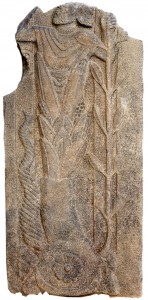 University of Münster archaeologists excavating the ruins of a medieval monastery near the southeastern Turkish city of Gaziantep have discovered a basalt stele carved with a figure of a previously unknown deity. The monastery of Mar Solomon (Saint Solomon) was built in the early Middle Ages over the remains of the Roman-era temple to Jupiter Dolichenus, a deity who was a syncretized combination of the Greco-Roman thunderer, king of the Olympian gods, and the Hittite sky and storm god Tesub-Hadad. Before the Roman temple there was a sanctuary to Tesub-Hadad on the hill known today as Dülük-Baba Tepesi. The stele was recycled for use as building material in the wall of the monastery.
University of Münster archaeologists excavating the ruins of a medieval monastery near the southeastern Turkish city of Gaziantep have discovered a basalt stele carved with a figure of a previously unknown deity. The monastery of Mar Solomon (Saint Solomon) was built in the early Middle Ages over the remains of the Roman-era temple to Jupiter Dolichenus, a deity who was a syncretized combination of the Greco-Roman thunderer, king of the Olympian gods, and the Hittite sky and storm god Tesub-Hadad. Before the Roman temple there was a sanctuary to Tesub-Hadad on the hill known today as Dülük-Baba Tepesi. The stele was recycled for use as building material in the wall of the monastery.
Archaeologist Blömer described the depiction: “The basalt stele shows a deity growing from a chalice of leaves. Its long stem rises from a cone that is ornamented with astral symbols. From the sides of the cone grow a long horn and a tree, which the deity clasps with his right hand. The pictorial elements suggest that a fertility god is depicted.” There are striking iconographic details such as the composition of the beard or the posture of the arms, which point to Iron Age depictions from the early 1st millennium B.C.
Hundreds of seals from the pre-Roman sanctuary have been found on the site, many of them carved with religious imagery and symbolism that are giving archaeologists new insight into worship practices at the sanctuary in the 1st millennium B.C. The discovery of the fertility god relief is an exciting addition to the archaeological record, and particularly relevant to the team’s investigation of how local cults survived over the millennia and in some cases expanded from their native contexts to widespread religions with adherents all over the Roman empire. Since ancient written sources — usually Roman elites — are unreliable documentation of Near Asian religions, archaeological sources are invaluable.
Excavation director Prof. Dr. Engelbert Winter:
“The image is remarkably well preserved. It provides valuable insights into the beliefs of the Romans and into the continued existence of ancient Near Eastern traditions. However, extensive research is necessary before we will be able to accurately identify the deity.”
Although Doliche was a small town, the empire-spanning prominence of the sanctuary of Jupiter Dolichenus transitioned into the Christian era. It was an episcopal see at least as early as the 4th century, and remains a titular see of the Roman Catholic Church to this day even though there’s nothing there but a glorious wealth of archaeological remains. The monastery of Mar Solomon was in use through the era of the crusades, but it was only known to archaeologists through written sources until the remains were first discovered in 2010.
Now the entire site is being transformed into an archaeological park even as excavations continue. The ruins are being carefully preserved and a trail was put in last year so visitors can view the Jupiter Dolichenus sanctuary and the remains of the monastery.